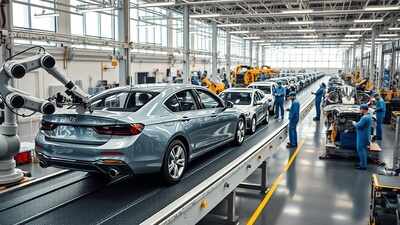India’s top car makers Maruti Suzuki, Hyundai Motor India and Tata Motors, are gearing up to expand production by 20–40% in the coming months. The ramp up comes after a sharp revival in vehicle demand following the recent Goods and Services Tax (GST) cuts. Maruti Suzuki, the country’s largest carmaker, plans to produce over 200,000 vehicles in November, compared with an average of 172,000 units a month till September, according to people familiar with the company’s plans. The production push will mark a record for the month, which typically sees manufacturers scale back dispatches after the festive season rush, as per an ET report.
Tata Motors has instructed its suppliers to prepare for output of 65,000–70,000 vehicles every month, a notable rise from an average of 47,000 units produced in the first half of the fiscal year. Meanwhile, Hyundai Motor India has started operating two shifts at its second plant in Talegaon, Maharashtra, increasing capacity by up to 20%. Passenger vehicle sales in India hit a record 557,373 units in October, driven by festive-season demand and post-GST price benefits that have depleted dealership stocks. Maruti Suzuki’s retail sales alone jumped 20% to 242,096 units last month. Partho Banerjee, senior executive officer for marketing and sales at Maruti Suzuki, said the company began November with 104,000 vehicles in stock, enough to last 19 days, and 350,000 pending orders. “Our production teams are working overtime, even on a few Sundays, to maximise supplies and reduce wait time,” Banerjee said. Tarun Garg, chief operating officer at Hyundai Motor India, said the GST cuts had a significant impact on sales. “We (at Hyundai) were constrained by capacity (earlier). But now with the Pune plant coming in, we should see an upside (in production) by 20%,” he told ET, adding that the company plans to strengthen its presence through new products and additional capacity. Tata Motors is equally upbeat. The festive season has “brought strong momentum to our retail performance, supported by healthy network stock levels and the positive impact of GST benefits,” said Amit Kamat, chief commercial officer, Tata Motors Passenger Vehicles. He added that the company expects growth to continue in the second half of the fiscal year, supported by a strong order book and upcoming launches. Maruti Suzuki also expects steady growth in the coming months. In its recent post-earnings call, the automaker said it anticipates a 6% rise in industry sales in the second half of FY26, after a 1% decline in the first half. According to S&P Global Mobility, which tracks vehicle production and sales on a calendar-year basis, India’s car market outlook for 2025 remains stable despite temporary disruptions caused by the timing of the GST rate cut. The firm expects the recent demand surge to offset earlier slowdowns and extend into next year. Gaurav Vangaal, associate director for light vehicles in the India subcontinent at S&P Global Mobility, told ET, that before the tax cuts, vehicle production was expected to rise 1–2% in 2026. “We now feel this would be much higher at 6–7%.” In the first six months of this fiscal year, production of cars, sedans and utility vehicles in India rose 3.8% to 2.57 million units, while exports increased 18% to 445,884 units, according to data from the Society of Indian Automobile Manufacturers (SIAM). Domestic wholesales, however, dipped 1.4%. SIAM is yet to release wholesale and production data for October.








